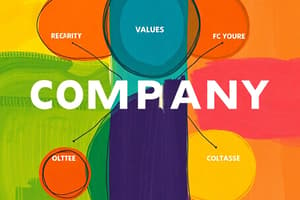Podcast
Questions and Answers
In scenarios where an organization's espoused values significantly diverge from its enacted values, and employees primarily respond to tangible rewards while demonstrating minimal intrinsic motivation, which of the following strategies would MOST effectively catalyze the development of a strong, integrated organizational culture?
In scenarios where an organization's espoused values significantly diverge from its enacted values, and employees primarily respond to tangible rewards while demonstrating minimal intrinsic motivation, which of the following strategies would MOST effectively catalyze the development of a strong, integrated organizational culture?
- Instituting a series of 'cultural audits' conducted by senior management to identify and rectify misalignments between espoused and enacted values, with corrective actions enforced through disciplinary measures.
- Implementing a zero-tolerance policy for any behavior not explicitly aligned with espoused values, coupled with mandatory ethics training sessions led by external consultants.
- Cultivating authentic leadership at all organizational levels, prioritizing leaders who intrinsically embody and consistently model the desired cultural values, and empowering them to foster value-congruent behaviors through mentorship and relational influence. (correct)
- Restructuring the compensation system to heavily emphasize performance-based bonuses tied to quantifiable metrics, while simultaneously reducing investment in non-monetary recognition programs.
Considering the complexities of organizational culture, which of the following statements BEST encapsulates the nuanced relationship between a strong organizational culture and a firm's adaptability within a rapidly evolving market landscape?
Considering the complexities of organizational culture, which of the following statements BEST encapsulates the nuanced relationship between a strong organizational culture and a firm's adaptability within a rapidly evolving market landscape?
- Strong organizational cultures exclusively benefit firms operating in highly regulated or stable industries, whereas firms in dynamic sectors should actively cultivate cultural ambiguity to maximize flexibility.
- While a strong organizational culture can provide internal stability, it may paradoxically impede a firm's capacity to embrace radical innovations or disruptive strategies necessary for long-term market relevance. (correct)
- A strong organizational culture invariably enhances a firm's ability to quickly adapt to market changes, fostering a collective sense of agility and innovation.
- The strength of an organization's culture has a negligible impact on its adaptive capacity, as market responsiveness is primarily determined by strategic resource allocation and technological capabilities.
Given the inherent challenges in quantifying the impact of 'Person-Organization Fit' on employee performance, which rigorous methodological approach would yield the MOST ecologically valid and actionable insights for optimizing talent management strategies?
Given the inherent challenges in quantifying the impact of 'Person-Organization Fit' on employee performance, which rigorous methodological approach would yield the MOST ecologically valid and actionable insights for optimizing talent management strategies?
- A longitudinal mixed-methods study combining ethnographic observations of workplace interactions with discrete choice experiments to disentangle the relative influence of value alignment on task performance, citizenship behavior, and counterproductive work behaviors. (correct)
- A series of controlled laboratory experiments manipulating hypothetical scenarios of value conflict to gauge participants' behavioral intentions and cognitive appraisals under conditions of induced psychological stress.
- A meta-analysis synthesizing findings from existing empirical studies that have examined the relationship between P-O fit and various performance indicators across diverse organizational contexts.
- A large-scale quantitative survey employing a standardized psychometric instrument to assess value congruence, correlated with objective performance metrics derived from annual performance reviews.
In the context of organizational culture, consider a multinational corporation undergoing a merger. The pre-merger cultures of the two entities are markedly different: one characterized by hierarchical decision-making and risk aversion, the other by flat structures and entrepreneurial risk-taking. Which integration approach would MOST effectively mitigate cultural clashes and foster a synergistic post-merger culture?
In the context of organizational culture, consider a multinational corporation undergoing a merger. The pre-merger cultures of the two entities are markedly different: one characterized by hierarchical decision-making and risk aversion, the other by flat structures and entrepreneurial risk-taking. Which integration approach would MOST effectively mitigate cultural clashes and foster a synergistic post-merger culture?
A global tech company, historically renowned for its fiercely competitive and individualistic culture, now recognizes the imperative to cultivate greater collaboration and knowledge sharing to sustain innovation. Which of the following interventions would MOST effectively catalyze a cultural shift towards collectivism, while preserving the company's high-performance orientation?
A global tech company, historically renowned for its fiercely competitive and individualistic culture, now recognizes the imperative to cultivate greater collaboration and knowledge sharing to sustain innovation. Which of the following interventions would MOST effectively catalyze a cultural shift towards collectivism, while preserving the company's high-performance orientation?
Considering the ethical dimensions of organizational culture, which of the following scenarios presents the MOST acute dilemma regarding the potential for a strong culture to inadvertently foster unethical behavior?
Considering the ethical dimensions of organizational culture, which of the following scenarios presents the MOST acute dilemma regarding the potential for a strong culture to inadvertently foster unethical behavior?
When attempting to diagnose sources of organizational underperformance related to culture, which analytical approach would prove MOST incisive in differentiating between symptoms and root causes?
When attempting to diagnose sources of organizational underperformance related to culture, which analytical approach would prove MOST incisive in differentiating between symptoms and root causes?
Which strategic intervention would MOST effectively address a situation where a dominant organizational culture inadvertently marginalizes diverse perspectives, stifles innovation, and reinforces systemic biases, while preserving core values?
Which strategic intervention would MOST effectively address a situation where a dominant organizational culture inadvertently marginalizes diverse perspectives, stifles innovation, and reinforces systemic biases, while preserving core values?
Which of the following scenarios exemplifies a counterculture effectively driving positive organizational change, rather than simply manifesting as resistance or dissension?
Which of the following scenarios exemplifies a counterculture effectively driving positive organizational change, rather than simply manifesting as resistance or dissension?
Considering that organizational culture is subtly communicated and reinforced through various channels, which of the following factors MOST significantly contributes to the tacit transmission of cultural norms, values, and assumptions within an organization?
Considering that organizational culture is subtly communicated and reinforced through various channels, which of the following factors MOST significantly contributes to the tacit transmission of cultural norms, values, and assumptions within an organization?
In an organization aiming to cultivate a culture of continuous improvement, which of the following performance management strategies would be MOST effective in fostering a growth mindset and facilitating ongoing learning and adaptation?
In an organization aiming to cultivate a culture of continuous improvement, which of the following performance management strategies would be MOST effective in fostering a growth mindset and facilitating ongoing learning and adaptation?
Considering the long-term implications of leadership succession on organizational culture, which of the following approaches would MOST effectively ensure the continuity of core values, while fostering adaptability and innovation?
Considering the long-term implications of leadership succession on organizational culture, which of the following approaches would MOST effectively ensure the continuity of core values, while fostering adaptability and innovation?
If a company’s IT department consistently delays repairs and is taking long breaks, which of the following statements is MOST accurate?
If a company’s IT department consistently delays repairs and is taking long breaks, which of the following statements is MOST accurate?
Which statement BEST describes “Attraction - Selection and Attrition“?
Which statement BEST describes “Attraction - Selection and Attrition“?
Which of the following BEST describes the manifestations of an organisational culture that everyone can see or talk about?
Which of the following BEST describes the manifestations of an organisational culture that everyone can see or talk about?
When considering the impact of organizational culture on employee behavior, which theoretical perspective offers the MOST comprehensive framework for understanding the complex interplay between individual agency and cultural determinism?
When considering the impact of organizational culture on employee behavior, which theoretical perspective offers the MOST comprehensive framework for understanding the complex interplay between individual agency and cultural determinism?
Which of the following organizational practices would MOST effectively foster the emergence and proliferation of constructive subcultures, without undermining the cohesiveness of the dominant culture?
Which of the following organizational practices would MOST effectively foster the emergence and proliferation of constructive subcultures, without undermining the cohesiveness of the dominant culture?
Considering that the effectiveness of organizational culture is contingent upon alignment with external environmental demands, which diagnostic framework would prove MOST valuable in assessing the degree of congruence between a firm's internal culture and its external competitive landscape?
Considering that the effectiveness of organizational culture is contingent upon alignment with external environmental demands, which diagnostic framework would prove MOST valuable in assessing the degree of congruence between a firm's internal culture and its external competitive landscape?
When evaluating the ethical implications of 'strong' organizational cultures, which philosophical framework offers the MOST insightful lens for analyzing the potential for such cultures to inadvertently foster unethical behavior through conformity and groupthink?
When evaluating the ethical implications of 'strong' organizational cultures, which philosophical framework offers the MOST insightful lens for analyzing the potential for such cultures to inadvertently foster unethical behavior through conformity and groupthink?
In organizations pursuing radical innovation, which paradoxical leadership approach would be MOST effective in fostering a culture that embraces both experimentation and disciplined execution?
In organizations pursuing radical innovation, which paradoxical leadership approach would be MOST effective in fostering a culture that embraces both experimentation and disciplined execution?
Flashcards
Strong Culture
Strong Culture
Employees align with organizational values and behave consistently, creating a sense of belonging.
Weak Culture
Weak Culture
Employees act independently without strong alignment to company values and more resistance to cultural norms.
Pros of a Strong Culture
Pros of a Strong Culture
Differentiates the company, encourages commitment, and provides stability/unity.
Cons of a Strong Culture
Cons of a Strong Culture
Signup and view all the flashcards
Dominant Culture
Dominant Culture
Signup and view all the flashcards
Subcultures
Subcultures
Signup and view all the flashcards
Countercultures
Countercultures
Signup and view all the flashcards
Leadership Role Modeling
Leadership Role Modeling
Signup and view all the flashcards
Hiring Practices (ASA Theory)
Hiring Practices (ASA Theory)
Signup and view all the flashcards
Socialization
Socialization
Signup and view all the flashcards
Rewards and Recognition
Rewards and Recognition
Signup and view all the flashcards
New Leadership
New Leadership
Signup and view all the flashcards
Mergers & Acquisitions
Mergers & Acquisitions
Signup and view all the flashcards
Shifting Strategies & Values
Shifting Strategies & Values
Signup and view all the flashcards
Person-Organization Fit
Person-Organization Fit
Signup and view all the flashcards
Study Notes
Strength of Organisational Culture
- Strong cultures see employees aligned with organisational values and behaving consistently.
- Strong cultures create a sense of belonging and identification among employees.
- Strong culture can be prone to groupthink and resistant to change.
- For example, Disney employees ("cast members") uphold strict brand values.
- Weak cultures are characterised by employees acting independently, without strong alignment to company values.
- There is more resistance to cultural norms and expectations.
Pros and Cons of a Strong Culture
- A strong culture differentiates a company from its competitors.
- Employee commitment and consistent behaviour are encouraged by a strong culture.
- Strong cultures provide stability and unity.
- Strong cultures can make it difficult to merge with other organisations.
- They can limit diversity of thought.
- Resistance to change is a potential downside (e.g., Kodak’s failure to adapt to digital photography).
Types of Organisational Culture
- A dominant culture is characterised by core values that are shared by the majority of employees.
- Subcultures are smaller groups within an organisation that have distinct norms, formed due to strong leaders, different departments, or geographical locations.
- Countercultures are subcultures that actively oppose the dominant culture.
- For example, a marketing team in a traditional finance company may have a more creative, relaxed culture compared to the overall conservative corporate environment.
Maintaining and Changing Organisational Culture
- Organisational culture can be strengthened through the actions of founders and leaders.
- Culturally consistent rewards help strengthen organisational culture.
- Selecting and socializing employees helps strengthen organisational culture.
- Aligning artifacts helps strengthen organisational culture.
How Culture is Maintained
- Leadership Role Modelling, where employees follow the behaviour of leaders.
- Hiring Practices involves Attraction, Selection, and Attrition (ASA Theory).
- Employees are attracted to companies that match their values.
- Companies hire people who fit their culture.
- Those who do not fit eventually leave.
- For example, Enron reinforced an elite, high-risk culture among employees.
- It involves Socialisation, including pre-employment (realistic job previews).
- There is an "Encounter" phase (adjusting to reality) and Role Management (becoming an "insider").
- Rewards and Recognition reinforce cultural values through promotions, performance management, and incentives.
Changing Organisational Culture
- New Leadership: Leaders bring new strategies and values (e.g., Satya Nadella at Microsoft shifted to a growth mindset culture).
- Mergers & Acquisitions: Two companies with different cultures merge, often leading to cultural clashes.
- Shifting Strategies & Values: Adapting to market trends and internal needs.
Impact of Culture on Performance
- Person-Organisation Fit is the degree to which an employee’s values match the company’s culture.
- Effects can be a weak positive effect on performance; culture alone does not guarantee high performance.
- There can be a strong positive effect on commitment; employees who fit the culture are more engaged and committed.
Conclusion
- Organisational culture shapes employee behaviour and company success.
- A strong culture has advantages but can limit flexibility.
- Leaders play a critical role in maintaining or changing culture.
- Employee fit with culture influences commitment and job satisfaction.
Studying That Suits You
Use AI to generate personalized quizzes and flashcards to suit your learning preferences.




